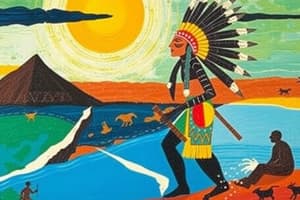Podcast
Questions and Answers
When did the Amerindians come to the Americas?
When did the Amerindians come to the Americas?
Around 12,000 years ago.
What were some reasons early migrants left their homeland?
What were some reasons early migrants left their homeland?
Extreme change in weather and migration of the giant mammoth.
What are the three distinct periods of Amerindian development?
What are the three distinct periods of Amerindian development?
Paleo-Indian, Meso-Indian, Neo-Indian.
What challenges did the early Amerindians face in the Guianas?
What challenges did the early Amerindians face in the Guianas?
What tools did the Paleo-Indians use for hunting?
What tools did the Paleo-Indians use for hunting?
Where did the first Amerindians enter Guyana from?
Where did the first Amerindians enter Guyana from?
The peopling of the Americas occurred around _____.
The peopling of the Americas occurred around _____.
Two challenges the early Amerindians faced were _____ and ____.
Two challenges the early Amerindians faced were _____ and ____.
The Guianas refer to _____.
The Guianas refer to _____.
What was a notable advancement during the Meso-Indian period?
What was a notable advancement during the Meso-Indian period?
How did the Meso-Indians adapt their settlement patterns?
How did the Meso-Indians adapt their settlement patterns?
Flashcards are hidden until you start studying
Study Notes
The Arrival of Amerindians in the Americas
- Around 12,000 years ago, the first people arrived in the Americas as the Ice Age allowed people to walk across the Bering Strait from East Asia into Alaska, eventually making their way south.
- The early migrants left their homeland due to weather changes, the resulting migration of giant mammoths (their food source), the need to escape enemies, and the desire for new adventures.
Distinct Amerindian Developmental Periods
- The Amerindian development is divided into three distinct periods: Paleo-Indian, Meso-Indian, and Neo-Indian.
Amerindian Migration and Guyana
- The migration of Amerindians led to the Guianas, a larger geographical area encompassing present-day Guyana, French Guiana, Suriname, Brazil, and Venezuela.
- The Guianas at the time were characterized by challenging environments, such as dense forests, large rivers, fierce animals, extreme temperatures, swamps, and mountains.
- The Amerindians adapted to their surroundings with limited resources and simple tools, despite being labeled as "savages" and "primitive" by Europeans.
The Paleo-Indian Period
- The first Amerindians, known as Paleo-Indians, entered Guyana around 11,000 years ago.
- They were hunters who used spear points made of stone to kill mammoths.
- These projectile points were typically two to six inches long and had straight or rounded bases.
- Paleo-Indians primarily lived in small nomadic groups and settled in the low, swampy coastal regions of northwestern Guyana.
- Evidence suggests that they formed settlements around large, swampy areas.
The Meso-Indian Period
- The Meso-Indian period emerged around 7,000 years ago, with Paleo-Indians evolving into hunter-gatherers.
- These groups used plants to produce oils, fibers, and dyes - early examples of horticultural experiments.
- Evidence indicates that these people occupied Barabina Hill near Mabaruma around that period.
- The hunter-gatherers created elaborate tools that led to technological innovation, such as bedrock grinding surfaces (polissoirs) for creating polished tools and intricate stone tools for various purposes.
- Some of the tools included bark beaters for extracting bark cloth, projectile points, chisels, axes, adzes, dug-out canoes, scrapers, gouges, awls, fish hooks, and personal ornaments.
- Bones and bush hog canines were used for additional tools and ornaments.
- Stone wedges shaped by adzes, chisels, and spokeshaves were used to split wood.
- The proximity of river settlements influenced the creation of dug-out canoes.
- Baskets made of woven materials were developed for fishing, storing water, and storing food.
- Settlements established during this period demonstrated different levels of permanency based on resource availability, leading to diverse cultural developments across the region.
Studying That Suits You
Use AI to generate personalized quizzes and flashcards to suit your learning preferences.




